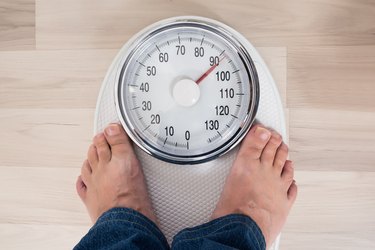
When it comes to weight loss, that number on the scale seems to hold a lot of power. If it's not budging, frustration sets in. But sometimes the number on the scale isn't the best way to measure progress. If you're staying on track with your diet and exercise program, you're most likely losing fat but gaining muscle -- and that's a good thing.
Building Muscle With Exercise
Video of the Day
When you're working out to lose weight, whether it's aerobic exercise or strength training, you're not only burning off calories and fat but also building muscle. A pound of muscle takes up less space than a pound of fat. If you're losing fat and gaining muscle at the same rate, your body size shrinks, but the number on the scale won't change.
Video of the Day
While you may be upset about the number on the scale, you shouldn't drop your exercise program. Diet and exercise together have been shown to be the most effective way people lose weight and keep it off, according to a 2014 meta-analysis study published in Systematic Reviews.
Read more: Why Do You Stop Losing Weight When Dieting?
Benefits of Lost Inches
Even though you're not seeing the number on the scale change, losing inches and fat is good for your health. People with a higher body fat percentage are at a greater risk of a number of health issues, including heart disease, diabetes, high blood pressure, issues with sleep, certain types of cancer and an overall lower quality of life.
Replacing pounds of fat with muscle is also good for your metabolism, which is the system in your body that burns calories. Adding 4.5 pounds of muscle can help you burn an extra 50 calories a day, according to Len Kravitz, Ph.D. on the University of New Mexico website. This may not seem like much in the grand scheme of things, but those extra 50 calories can add up.
Measuring Progress Without the Scale
Instead of obsessing about the number on the scale, use other tools to measure progress on your diet and exercise program. Clothing is a great tool for measuring progress. If your clothes are looser or they fit better, something good is happening.
If you need a number, measure and track inches lost. In fact, your waist measurement is a better tool than the number on the scale for measuring health, according to the National Heart, Lung and Blood Institute. Women should be shooting for a waist circumference of less than 35 inches, and men less than 40 inches. Measure your waist with a tape measure around your middle just above your hipbone.
Measuring body fat can also give you a good indication of how you're doing. You'll have to visit a trained professional to have it done, though. The skin caliper method is accurate and the most accessible and economical.
Read more: 3 Tips to Push Past a Weight-Loss Plateau
- University of New Mexico: Aerobics Vs. Resistance
- Sports Health: Letter to the Editor Response
- Systematic Reviews: Impact of Long-Term Lifestyle Programmes on Weight Loss and Cardiovascular Risk Factors in Overweight/Obese Participants: A Systematic Review and Network Meta-Analysis
- FamilyDoctor.org: What It Takes to Lose Weight
- Baylor College of Medicine: Adult Energy Needs and BMI Calculator
- Centers for Disease Control and Prevention: About Adult BMI
- University of New Mexico: Controversies in Metabolism
- National Heart, Lung and Blood Institute: Assessing Your Weight and Health Risk
- University of New Mexico: Understanding Body Composition